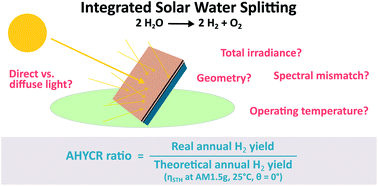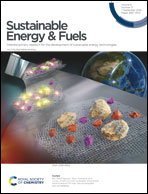The annual-hydrogen-yield-climatic-response ratio: evaluating the real-life performance of integrated solar water splitting devices†
Abstract
Integrated solar water splitting devices that produce hydrogen without the use of power inverters operate outdoors and are hence exposed to varying weather conditions. As a result, they might sometimes work at non-optimal operation points below or above the maximum power point of the photovoltaic component, which would directly translate into efficiency losses. Up until now, however, no common parameter describing and quantifying this and other real-life operating related losses (e.g. spectral mismatch) exists in the community. Therefore, the annual-hydrogen-yield-climatic-response (AHYCR) ratio is introduced as a figure of merit to evaluate the outdoor performance of integrated solar water splitting devices. This value is defined as the ratio between the real annual hydrogen yield and the theoretical yield assuming the solar-to-hydrogen device efficiency at standard conditions. This parameter is derived for an exemplary system based on state-of-the-art AlGaAs//Si dual-junction solar cells and an anion exchange membrane electrolyzer using hourly resolved climate data from a location in southern California and from reanalysis data of Antarctica. Moreover, the advantage of devices operating at low current densities over completely decoupled PV-electrolysis is discussed. This work will help to evaluate, compare and optimize the climatic response of solar water splitting devices in different climate zones.



 Please wait while we load your content...
Please wait while we load your content...